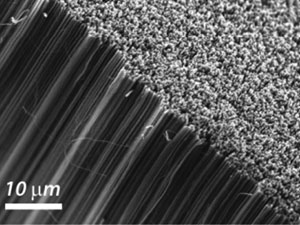UK scientists have shown that the sidewalls and closed ends of carbon nanotubes can support fast electron transfer, challenging the belief that they are electrochemically inert.
Carbon nanotubes (CNTs) have wide ranging electrochemical applications for sensing and energy. Forests of vertically aligned CNTs have been proposed for use as electrodes, but it was thought that the inert sidewalls would have to be insulated and the ends opened to allow electron transfer.
Scientists from the University of Warwick have now challenged this position by showing that the sidewalls and closed ends of CNTs can support fast electron transfer.
See the full article in Chemistry World
Link to journal article
Electrochemistry at carbon nanotube forests: sidewalls and closed ends allow fast electron transfer
Thomas S. Miller, Neil Ebejer, Aleix G. Güell, Julie V. Macpherson and Patrick R. Unwin
Chem. Commun., 2012, Advance Article, DOI: 10.1039/C2CC32890A, Communication











